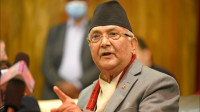National
Cost of elderly allowances swells by Rs7 billion in a year
As many as 113,911 new beneficiaries added due to the lowering of eligibility age by the current government.
Prithvi Man Shrestha
The government expects its expenses on elderly allowances to rise by more than Rs7 billion in the current fiscal year due to the lowering of the eligibility age.
Presenting the budget for the current fiscal year in May, the government lowered the eligibility age, thereby increasing the financial burden on state coffers, which is under pressure due to lower-than-expected revenue generated in recent years.
During the first quarter of the current fiscal year, a total of 113,911 new beneficiaries were added to the elderly list due to the lowering of the eligibility age, according to the Department of National ID and Civil Registration.
There were 1,312,015 beneficiaries aged over 70 years till the end of last fiscal year (2021-22) and the number increased to 1,425,926 during the first quarter of the current fiscal, the department’s statistics showed.
The share of eldery beneficiaries aged above 68 years now stands at 39.91 percent of the total beneficiaries, a rise from 36.70 percent at the end of the last fiscal year. There are about 3.57 million beneficiaries who get cash transfers from the government.
Based on the rise in the number of beneficiaries aged above 68 years, the government will have to spend an extra Rs5.46 billion by the end of current fiscal year.
“We expect the number of beneficiaries to rise by more than 200,000 by the end of current fiscal year and the additional cost by around Rs7.5 billion,” said Sagarmani Pathak, director at the social security section of the department.
Whenever a person crosses the age of 68 years, he or she will be eligible to get the elderly allowance from the government.
“Given the increased life expectancy of the Nepali people, the number of beneficiaries under this category will continue to grow,” said Pathak.
However, the growing burden of social security allowances has not stopped political parties from continuing with the policy, which regularly adds a significant financial burden on the state coffers.
While presenting the budget for the fiscal year 2021-22, the erstwhile KP Sharma Oli government increased all social security allowances by 33 percent, including the elderly allowance to Rs4,000 per month from Rs3,000 per month.
The Sher Bahadur Deuba-led coalition government, which came to power in July last year, took another decision on the elderly allowances.
As a result, the government’s expenses on social security, based on cash transfers, have been rising. In the fiscal year 2020-21, the government spent Rs 68.61 billion on social security allowances, according to the Department of National ID and Civil Registration.
The government expected it to rise to Rs88.68 billion in the last fiscal year 2021-22. As per the budgetary provision, Rs105.70 billion have been allocated for the current fiscal year.
Besides direct cash transfers, the government spends heavily on various other social security schemes, including medical insurances and subsidies, which also burden the state coffers.
Political parties are still making new promises ahead of federal and provincial elections scheduled for November 20.
A number of political parties have promised to increase the social security allowance. “The government decision to lower the eligibility for elderly allowance is arbitrary, as it has been done when the average life expectancy of Nepali people is rising,” said Former Finance Secretary Suman Sharma. “Increasing cash handouts will only increase dependency, affecting people’s productivity.”
Meanwhile, the government made a downward revision of its revenue targets in two consecutive fiscal years. There is doubt over whether the government will collect its targeted revenue in the next fiscal year as well, as it has been forced to ban imports of major revenue-generating items, including automobiles, amid depleting foreign exchange reserves.
In fact, the government tax offices have been missing their revenue collection targets. Both the Department of Customs and the Inland Revenue Department reported disappointing revenue collections, compared to their targets.
The Department of Customs reported a collection of only 73 percent of target as of September 29 as the imports of major revenue generating items such as vehicles, continue to be restricted.
Likewise, the Inland Revenue Department reported collection of 91 percent of targeted revenue during the first quarter of this fiscal. “There are not enough resources to support the promises of the political parties on social security,” said Sharma.
According to a World Bank report, the overall public spending on social protection rose rapidly in Nepal for a decade—from fiscal year 2010-11 to fiscal 2019-20.
According to the report, the government’s spending on overall social protection was Rs26 billion in fiscal year 2010-11, which surged to Rs189 billion in fiscal 2019-20.
The social security scheme was launched in 1994-95 by the government led by Manmohan Adhikari, a UML leader. The scope of the scheme, which started by providing Rs100 a month to the elderly, was gradually expanded to include single women and people with disabilities in 1996-97. Members of communities on the verge of extinction and disabled persons were also added to the list in 2008-09. Dalit children made it to the list in 2010-11, while widows were included in 2011-12. Dalits from the Karnali region were added in 2016-17 and children from 15 districts with low human development index values were made beneficiaries of cash transfers in 2018-19. The number of such districts has gone up to 26 this fiscal year.
“The government needs to strengthen its social security system such as the health insurance scheme while reducing the cash handouts,” said Sharma, the former finance secretary. “Likewise, the country’s economy and the government’s overall resources should be increased to finance the social security schemes.”




 7.15°C Kathmandu
7.15°C Kathmandu










%20(1).jpg&w=300&height=200)



